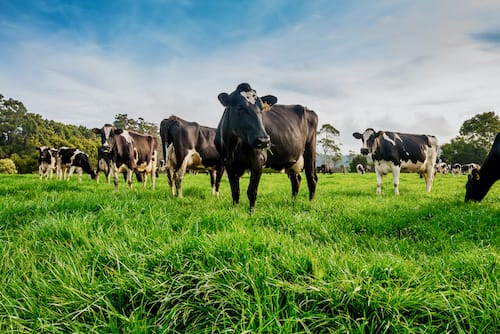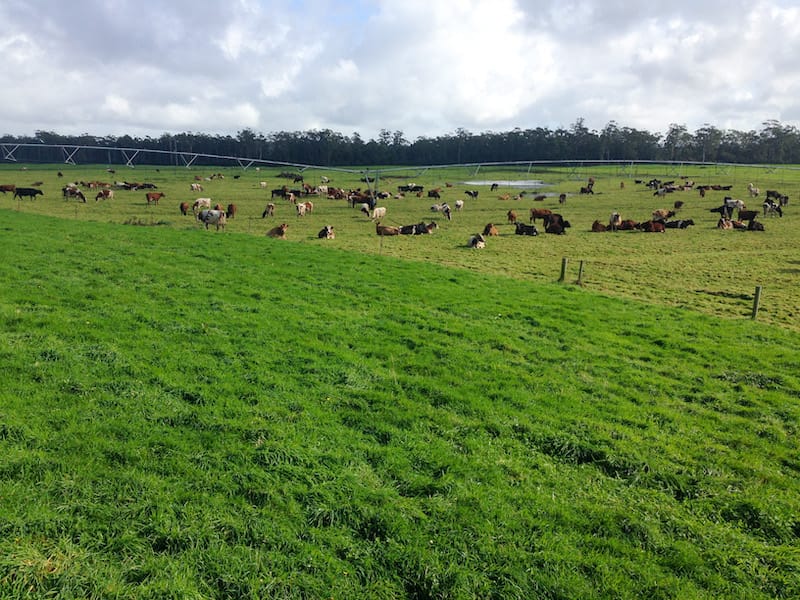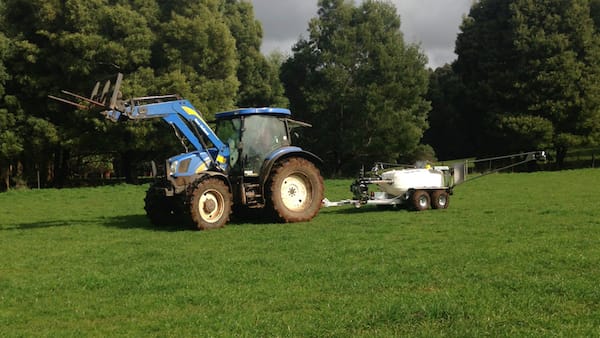As farmers, most of us went into farming for our love of nature and animals. You may have even found out at an early age about your fondness and talent in producing food. But, as we age, we realise that there is money in farming. As you're reading this blog today, you may be depending on agriculture for your primary source of income. This position is something to be very proud of because, indeed, farming is a viable and sustainable livelihood. Similarly, as farmers, sometimes we tend to make profit-driven management decisions, instead of production-driven. If you know how to make the most out of your pasture, you'll realise that there is a proper balance in pushing for profitability and productivity of your pasture.
In this blog, we will discuss the following:
1. Drivers of profit with your pasture.
2. How a well-managed pasture makes you income.
3. Tips to increase your farm profit through pasture management.

Drivers of profit with your pasture
The first step to increase your profitability despite the competitive and unpredictable environment is to be able to understand the drivers for profit that are at play. And the management plans that can manipulate these drivers. For many farmers, they consider the price of farm products as the most significant impact on their income. But did you know that small, seemingly inconsequential changes across the business are often more doable and can have a more substantial overall effect on your income?
To improve profitability in an increasingly competitive and volatile environment, you need to have an understanding of your profit drivers and have tactical management plans in place.
The drivers of your farm profit are the following:
- Price
- Production
- Cost
- Management
Many will say that the price will have the most substantial impact on profit. However, small changes made across your business will often be more achievable and can have a more considerable profit impact. For example, a 10% increase in the production and price of products partnered with another 10% reduction in costs may double your profit.
Always remember the following:
- Farming and agriculture are ever-changing and ever-growing industries, which make them very volatile. Knowing the drivers of profit of your farm will help you analyse your capacity to endure adverse farming conditions. And then further to seizing opportunities for making well-calculated and well-informed decisions, especially concerning your expenditure.
- An increase in production, higher prices, or lower costs can contribute to either maintain or increase profits.
- Gross margins are not the only indicator of profit. You should also analyse your operating expenses, allowances for capital replacement, management, finance costs, and other costs of doing business.
- While the price may have the most significant impact on increasing your income, it may be hard to influence. That is why making a few small changes across your farm may be more doable and more profitable overall at the same time.
- Instead of only focusing on increasing farm profit, you must also make sure that you are practising limiting losses. You can only do this if you understand the flexibility and resilience of your farm’s finances.
- In considering accessing additional debt or capital expenditure, make sure that you know your farm’s financial capacity.
- You can increase your profitability with the use of essential farm management skills and practices.

How a well-managed pasture makes you income
You may ask, “So how can good pasture management increase my profitability?”
Let me paint this picture for you.
Proper pasture management, characterised by a good grazing practice is the start of this picture. When swards of pasture thrive well, they look after your animals who proceed to look after you. You then respond, by following the law of reciprocity, looking after your animals and looking after your pasture. You see, as living organisms, we need treating with care. With this care, we respond positively and flourish accordingly.
Within a few years, you can turn a weedy pasture, where animals are fed poor-quality forage, into highly-productive pastures that provide rocket fuel for your animals. With this, the high quality feeds from the well-managed pasture prove to be of lower cost than purchased feed.
Through proper pasture management:
Your livestock can consume a ration high in nutrients. Just think that you'll be able to reduce or eliminate feeding grains or conserved forages during grazing.
In a nutshell, where there's pasture, there's milk and where there's milk there's money.
Although there may be expenses related to starting a grazing system, such as fencing and investments in seeds and soil fertility, the benefits of a well-managed pasture generally overweigh the costs. Apart from the lower costs attributed to reduced or eliminated purchase of supplemental feeds, labour and input costs can also lower because your livestock harvests their feed. This scenario can reduce or eliminate the need to do mechanical harvesting, storage, and feeding with the right stocking rate at the right time of year.
Add to this, well-managed pastures provide an even supply of seasonal available quality and quantity of feed. This supply will pasture growth rates to increase across the year, which in turn reduces the grazing pressure of growth rate demand. Can you see the story here? I'm showing you how to dilute operational expenses such as fuel and labour, giving you a resilient farm production system.
Overall, good pasture management improves financial sustainability. But can lower costs and sustainable production strategies are some of the many positive results of a well-managed pasture. Below are more benefits of a well-managed pasture for farmers and their livestock.
- Healthier livestock that lives longer because of better nutrition and lower stress levels, which increases your income.
- Fewer fertiliser expenses and time spent on manure spreading
- Fewer dollars spent on renovating pastures.
- New market opportunities to health-conscious consumers. We all know that healthy livestock produces meat and milk that are highly nutritious.
- Healthier livestock also entails lower veterinary bills.
- A well-managed pasture also allows for ecological benefits, such as being able to grow higher-density populations of deep-rooted perennial plants and promoting healthy and biologically active soils.

Tips to increase your farm profit through pasture management
Subdivision of paddocks to create efficient workflows and productivity gains.
Fencing is recommended to be the first investment to sub-divide pastures. Why is sub-diving important? Because it gives your pasture proper rest period and reduces grass competition. Farmers who sub-divide their pastures properly are often amazed at how big of a difference it makes. The science is in!
The more paddocks established, the better.
The minimum number of paddocks recommended is approx. 30 to 40, since this will provide greater time for your forage to rest without too many portable fences. This rest gives the pasture plants the proper rest period and less stress from competition among each other. Increasing the number of paddocks increases the benefits of doing so.
Allot only a 2 to 3 days or less for grazing a paddock.
Make sure that you know the area of your paddocks and see to it that the majority of your forage will be grazed down to 5 centimetres (1500-1700KgDM/ha) in the allotted time. Why is this important? Doing this will help prevent, if not stop, the grazing of the regrowth. Heck, why else do we offer remote pasture measuring and grazing management? Because it is integral to your farm profit!
Make paddocks square-shaped as much as possible.
This tip may seem obscure, but this advice is very practical. Square paddocks have higher grazing pressure and evenly-spread manure deposits as compared to paddocks that are longer than they are wide.
Pre-grazing pasture cover should be no more than 2800-3100KgDM/ha or between the second and third leaf depending on the season.
In spring, rest paddocks for approx. 15 to 20 days after grazing, matching growth rate demand with the growth rate. However, this rest period depends on heat and rainfall availability. During autumn and winter, the rest period increases upwards to 30 days towards 60 due to decreasing sunlight hours and temperature.
Any paddocks that grow above 3200KgDM/ha should be shut up and conserved, as fodder.
This tip is especially true during the spring months when your livestock can no longer keep up with your pasture growth. If this happens, you may rotate the livestock more rapidly. However, you have to be ready to harvest any paddocks that hit the threshold for conserving fodder.
Plan strategies for stockpiling feed inventory.
Setting aside late summer pastures for grazing in the fall, winter, or spring is called stockpiling or conserving fodder. This practice is very much applicable whenever there is surplus pasture growth. Doing this helps your livestock have access to summer grown grasses that stay more vegetative and hold feed value longer. This practice not only helps in pasture management but will significantly aid you in reducing feeding costs during autumn and winter.
Manage your soil nutrients.
Allowing your livestock to spread out its manure over your pastures can greatly improve your soil fertility. More so, it can aid in reducing your expenses for soil fertiliser. You can use stockpiling to make this possible, as it can help keep your livestock out on the pasture longer. You may also rotate winter hay feeding to different paddocks to further aid in spreading out your livestock's manure.
Remember that any bought-in supplements are bringing in nutrients that your livestock disperses for you. In dairy systems, you can take advantage of spreading effluent collected at the dairy, spreading the high nutrient-dense liquid to your paddocks that require it most. Importantly, saving on your fertiliser bill and closing the nutrient loop of your farm. All of which positively impacts your bottom line.
I do reply to every comment and would love to hear your experiences with weed control and which method you deploy in the comments below.
Happy farming!
- The Dedicated Team of Pasture.io, 2019-09-18